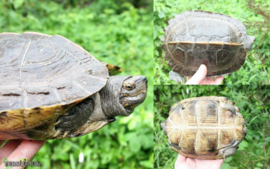Bar-headed goose
Anser indicus
Continents: Asia
Countries: Afghanistan, Bangladesh, Bhutan, China, India, Kazakhstan, Kyrgyzstan, Mongolia, Myanmar, Nepal, Pakistan, Russia, Tajikistan, Uzbekistan; introduced to Western Europe
Darker patches are breeding range, paler areas are wintering range
Biomes: Aquatic, Grassland, Taiga, Temperate; possibly Tundra
In the breeding range, this species breeds on open grasslands close to large bodies of standing water. During migration they travel over the Himalayas, and an increasing number of birds are now wintering on the cold Tibetan Plateau. In their wintering range in southern Asia, they favour wetlands and tropical grasslands.
Red List status: Least Concern, with a declining population.
Captive presence: This is probably the most common goose species in zoos. On Zootierliste, there are 149 zoos listed as holding them – 146 in Europe, 2 in Israel and 1 in Singapore. At least 14 zoos in North America also keep them. While this doesn’t sound like much it actually makes them the most commonly-held of all goose species in American zoos, even more than native geese like Canada, Hawaiian and snow geese.
Reasoning: A major reason for choosing the bar-headed over any other goose species is simply because of its prevalence in captivity. They are also one of the more visually appealing species, with their patterned plumage and mix of colours.
Because of their ubiquity in zoos, these geese can be kept in many different ways. They can be kept on simple waterfowl ponds or lakes, on ornamental lily ponds, in open paddocks, in aviaries, in the moats of primate islands and in walkthrough enclosures – they seem to be friendlier than some of the other goose species and so would suit the walkthrough feature. They have even been used in free-flight bird displays, although I’m unsure if any habitat bird would ever get such a feature.
These birds are routinely kept in mixed-species enclosures and would add a lot to all sorts of Asian mixed exhibits. They have been kept in real zoos with Indian rhinoceros, Malayan tapir, greater flamingo and Bactrian camel and I imagine they could also mix with Przewalski’s horse, water buffalo, red-crowned crane and red panda. Apart from these, they have also been mixed with various deer and antelopes, pelicans and freshwater turtles.
The bar-headed goose would add both movement and noise to zoos – they naturally live in large flocks so could be kept in considerable groups in the game and, unlike many geese, their honks are generally softer and more musical than harsh-sounding.
Variations (if any): Bar-headed geese can show some subtle variations in plumage. While the head, neck and wings generally remain the same colour, with differences often due to environmental factors (like staining of the head when feeding), the flanks can vary from pale grey to a dark brown. These two variants would probably be sufficient, with grey the more dominant colour.
References:
A picture of bar-headed geese free-roaming within the grounds of a zoo:
Karlsruhe Zoo visited on 10.09.2022

www.zoochat.com
A picture of a single-species enclosure for bar-headed geese:
The enclosure for bar-headed goose, part of the Maharajah Jungle Trek.

www.zoochat.com
Another picture showing part of a bar-headed goose single-species enclosure, with the type of barrier required:
For details, see my review http://www.zoochat.com/22/review-busch-gardens-tampa-253464/

www.zoochat.com
A photograph of a bar-headed goose on an ornamental lily pond:

www.zoochat.com
Another type of bar-headed goose enclosure; being kept in the moats of primate islands:
The moat and the surrounding little land parts are home to capybara (not seen during my visit) and bar-headed geese. / See my review here:...

www.zoochat.com
A picture showing bar-headed geese mixed with dromedaries (the dromedaries replaced earlier-held Bactrian camels):
June 5th 2016 View across the dromedary camel and bar-headed goose yard to the entrance of Tiger Passage and one of the bear grottos.

www.zoochat.com
A mixed enclosure for Indian rhino, blackbuck, sarus crane and bar-headed goose (visible behind the lake):
Indian rhino, blackbuck, sarus crane, bar-headed goose

www.zoochat.com
Bar-headed goose in a mixed enclosure with banteng, white-naped crane, blackbuck and (unpictured) Eld’s deer and ruddy shelduck:
Mixed exhibit with Banteng, Blackbuck, Burmese Brow-antlered Deer, White-naped Crane, Bar-headed Goose and Ruddy Shelduck.

www.zoochat.com
Photograph showing bar-headed geese (at the bottom of the picture) in a free-flight bird display at ZooParc de Beauval, France:

www.zoochat.com
This link has many calls of the bar-headed goose, including its honks, duet calls and hisses:

xeno-canto.org


